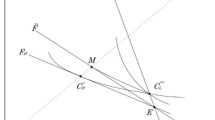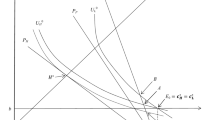Abstract
Game-theoretic models of mutual insurance are considered. Here a player chooses between participating in a mutual insurance fund or not. Player’s behavior depends on its risk aversion. Using a scalar coefficient of agent’s risk aversion degree, we define utility functions leading to the threshold behavior of agents. Next, the game-theoretic models of anonymous and non-anonymous insurants are studied and Nash equilibrium conditions are established for both models.
Similar content being viewed by others
References
Breer, V.V., Game-Theoretic Models of Collective Conformity Behavior, Autom. Remote Control, 2012, vol. 73, no. 10, pp. 1680–1692.
Breer, V.V., A Game-Theoretic Model of Non-anonymous Threshold Conformity Behavior, Autom. Remote Control, 2012, vol. 73, no. 7, pp. 1256–1264.
Burkov, V.N., Zalozhnev, A.Yu., Kulik, O.S., and Novikov, D.A., Mekhanizmy strakhovaniya v sotsial’no-ekonomicheskikh sistemakh (Insurance Mechanisms in Socio-economic Systems), Moscow: Inst. Probl. Upravlen., 2002.
Burkov, V.N. and Novikov, D.A., Kak upravlyat’ proektami (How to Manage Projects), Moscow: Sinteg, 1997.
Goubko, M.V. and Novikov, D.A., Teoriya igr v upravlenii organizatsionnymi sistemami (Game Theory and Organizational Systems Control), Moscow: Sinteg, 2002.
Ivashkin, E.I., Vzaimnoe strakhovanie (Mutual Insurance), Moscow: Ross. Ekonom. Akad., 2000.
von Neumann, J. and Morgenstern, O., Theory of Games and Economic Behavior, New York: Wiley, 1953. Translated under the title Teoriya igr i ekonomicheskoe povedenie, Moscow: Nauka, 1970.
Novikov, D.A., Insurance Mechanisms: Risk Redistribution and Data Manipulation, Probl. Bezopasn. Chrezvych. Situats., 1997, no. 5, pp. 44–55.
Obshchestva vzaimnogo strakhovaniya (Mutual Insurance Societies), Turbina, K.E., Ed., Moscow: Ankil, 1994.
Serbinovskii, B.Yu. and Gar’kusha, V.N., Strakhovoe delo (Insurance Business), Rostov-on-Don: Feniks, 2000.
Fishbern, P.C., Utility Theory for Decision Making, New York: Wiley, 1970. Translated under the title Teoriya poleznosti dlya prinyatiya reshenii, Moscow: Nauka, 1978.
Actuarial Science. Advances in the Statistics Science. Festschrift in Honor of Professor V.M. Josh’s 70th Birthday, Dordrecht: Reidel, 1987, vol. 6.
Granovetter, M., Threshold Models of Collective Behavior, AJS, 1978, vol. 83, no. 6, pp. 1420–1443.
Pratt, J., Risk Aversion in the Small and in the Large, Econometrica, 1964, vol. 52, no. 1, pp. 122–136.
Author information
Authors and Affiliations
Corresponding author
Additional information
Original Russian Text © V.V. Breer, D.A. Novikov, 2011, published in Matematicheskaya Teoriya Igr i Priloszheniya, 2011, No. 4, pp. 3–22.
Rights and permissions
About this article
Cite this article
Breer, V.V., Novikov, D.A. Threshold models of mutual insurance. Autom Remote Control 76, 897–908 (2015). https://doi.org/10.1134/S0005117915050148
Received:
Published:
Issue Date:
DOI: https://doi.org/10.1134/S0005117915050148




